#New Mexico Range
Text
youtube
#youtube#militarytraining#DFT Exercise#firepower demonstration#Korea#war games#military maneuvers#marksmanship#Marines#military training#shooting range#United States Air Force#New Mexico Range#military drills#military experience#weapons training#tactical training#Airmen#LIVE FIRE#combat training#United States Marines#military exercises
4 notes
·
View notes
Text

View of the A-002 Apollo Command Module Boilerplate 23 ad LES atop the Little Joe II launch vehicle at Complex 35, WSMR.
Date: December 7, 1964
NASA ID: S64-35835
#A-002#BP-23#Little Joe II#launch escape system#LES#Rocket#NASA#Apollo Program#Abort Test#December#1964#White Sands LC-36#LC-36#White Sands Missile Range#White Sands#New Mexico#my post
90 notes
·
View notes
Text
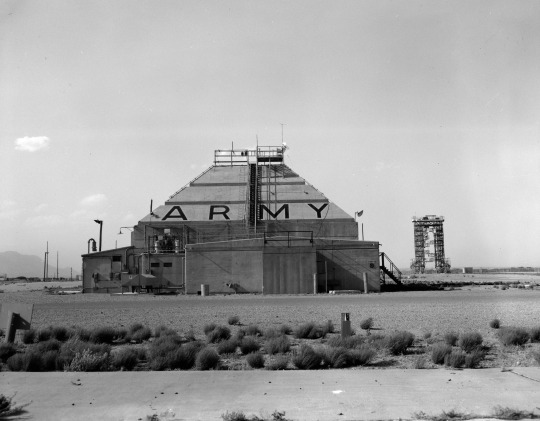
Army blockhouse by launch complex 32 at White Sands Missile Range, New Mexico, where the U.S. military tested captured V-2 rockets.
(Library of Congress)
#space#new mexico#architecture#military history#white sands#white sands missile range#bunker#blockhouse#concrete#army
83 notes
·
View notes
Text
anyways I think I'm warming to the idea of the Midwest in general
#colorado or new mexico is still very much plan a after this phd is done#but the front range metro areas are all very expensive and albuquerque is affordable but has limited job opportunities for me#and idk maybe the midwest wouldn't be so bad?#i don't vibe with the east coast and the political climate in the south is too generally fucked up#and granted ohio is also fucked up politically but it at least voted to protect abortion rights in the state constitution#but there's also michigan and illinois and minnesota
8 notes
·
View notes
Video
Cloud frenzy by Dave Arnold
Via Flickr:
Los Lunas, New Mexico USA Explore, August 23, 2022
#nm#nmex#new mex#new mexico#los lunas#wx#nmwx#nws Albuquerque#mountains#sunset#range#desert#lightning#lightening#storm#stormy#thunderstorm#spring#image#pic#us#usa#picture#severe#photo#photograph#photography#photographer#Dave Arnold#manzano
67 notes
·
View notes
Text
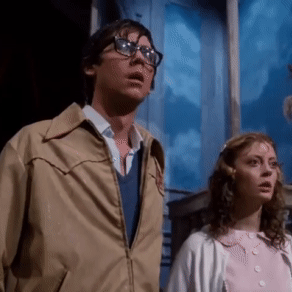





Brad's reactions to Frank
1975 Film -Barry Bostwick, 2015 UK-Ben Foster, 2016 Film-Ryan McCartan, 2018 Iceland-Jón Atli Jónasson , 2018-Korea Jin Tae-hwa (I think) and 2022 Mexico-Moisés Araiza as Brad Majors in The Rocky Horror Picture Show
(x) (x) (x) (x) (x) (x)
#love how the reactions range from ‘’oh shit I’m gay’’ ‘’do you see this shit Janet?’’#and ‘’ 🎶I’m being pulled in a new direction. but I think I like it. I think I like it🎶’’#brad majors#frank n furter#me making stuff#my gifs#musical theatre#musicals#the rocky horror show#rocky horror picture show#talking on tags#rhps frank#rhps#rhps 1975#rphs 2015#rhps 2016#rhps 2018 iceland#rhps korea#rhps 2022 mexico#barry bostwick#film ryan mccartan#moisés araiza#jón atli jónasson
98 notes
·
View notes
Text
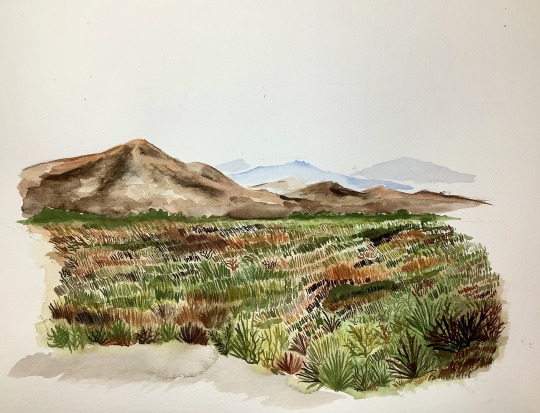
New Mexico Landscape, 2020
6 notes
·
View notes
Link
THIS MONTH, NEW MEXICO’S FAITHFUL will observe the Christmas season with cherished traditions. That’s especially true in Bernalillo, a small town north of Albuquerque that has resisted the urban advancement charging up to its edges. A twinkle-light parade and nine days of the traditional Las Posadas events mark holiday observances here. Catholic residents will recite prayers in the 1857 Santuario de San Lorenzo, which dates back to the era of Archbishop Jean-Baptiste Lamy. This isn’t a December-only kind of thing, though. In Bernalillo, the devoted who make la promesa have honored their faith, history, and sense of community every day for nearly 330 years.
Motorists zooming past on I-25 or pouring down US 550 from Rio Rancho may not suspect, much less experience, the depth of that devotion. But if you veer off those thoroughfares, Bernalillo unveils its laid-back identity—one that celebrates the past while laying out a post-pandemic welcome mat. A new museum recently joined the town’s list of reasons to visit. There’s also an Ancestral Pueblo historic site, old adobe buildings, and a classic dive bar with Prohibition roots. And, yes, the flagship outpost of the Range Café continues to pack in crowds with some of the best diner food (and art!) in the state.
“I encourage people to venture outside their normal routines,” says Mike Kloeppel, Bernalillo’s economic and community development director. “Especially for the holiday season, you should try to experience something different. Bernalillo is still a small town, where people know your first name and shake your hand. We do Christmas the old-fashioned way.”
7 notes
·
View notes
Text

Tina Cordova and her mother, Rosalie, relax at Bonito Lake, New Mexico, in 1960. Cordova says the lake—which lies within the estimated radioactive fallout zone—was a water source for area towns, including Carrizozo, Alamogordo, and Ruidoso. Courtesy of Anastacio and Rosalie Cordova
U.S. Lawmakers Move Urgently to Recognize Survivors of the First Atomic Bomb Test
The 1945 Trinity test produced heat 10,000 times greater than the surface of the sun and spread fallout across the country.
— By Lesley M.M. Blume | Published September 21, 2021 | July 29th, 2023
Barbara Kent joined Carmadean’s dance camp in the desert near Ruidoso, New Mexico, in the summer of 1945. During the day, she and nine other girls learned tap and ballet. At night, they slept in a cabin by a river. Early in the morning on July 16, 1945, Kent says that she —then 13—and the other campers were jolted out of their bunk beds by what felt like an enormous explosion nearby. Their dance instructor rushed the girls outside, worried that a heater on the premises might have burst.
“We were all just shocked … and then, all of a sudden, there was this big cloud overhead, and lights in the sky,” Kent recalls. “It even hurt our eyes when we looked up. The whole sky turned strange. It was as if the sun came out tremendous.”
A few hours later, she says, white flakes began to fall from above. Excited, the girls put on their bathing suits and, amid the flurries, began playing in the river. “We were grabbing all of this white, which we thought was snow, and we were putting it all over our faces,” Kent says. “But the strange thing, instead of being cold like snow, it was hot. And we all thought, ‘Well, the reason it’s hot is because it’s summer.’ We were just 13 years old.”
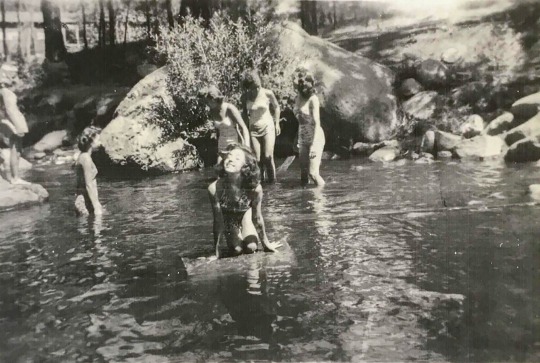
Thirteen-year-old Barbara Kent (center) and her fellow campers play in a river near Ruidoso, New Mexico, on July 16, 1945, in the hours after the bomb’s detonation. Fallout flakes drifted down that day and for days afterward. “We thought [it] was snow," Kent says. “But the strange thing, instead of being cold like snow, it was hot." Courtesy of Barbara Kent
The flakes were fallout from the Manhattan Project’s Trinity test, the world’s first atomic bomb detonation. It took place at 5:29 a.m. local time atop a hundred-foot steel tower 40 miles away at the Alamogordo Bombing and Gunnery Range, in Jornada del Muerto valley.
The site had been selected in part for its supposed isolation. In reality, thousands of people were within a 40-mile radius, some as close as 12 miles away. Yet all those living near the bomb site weren't warned that the test would take place. Nor were they evacuated beforehand or afterward, even as radioactive fallout continued to drop for days.
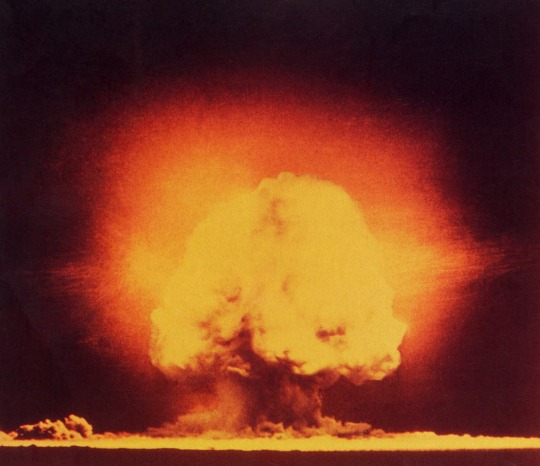
The Trinity test took place at 5:29 a.m. local time on July 16, 1945. It was three to five times more powerful than its creators had anticipated, producing heat 10,000 times greater than the surface of the sun. The explosion cloud may have reached a height of 70,000 feet. Photograph By Science History Images/ Alamy
In 1990, the U.S. Congress passed the Radiation Exposure Compensation Act (RECA), which has since dispensed over two billion dollars to more than 45,000 nuclear workers and “downwinders”—a term describing people who have lived near nuclear test sites conducted since World War II and may have been exposed to deadly radioactive fallout.

But those exposed during the Trinity test and its aftermath have never been eligible.
For years, Senator Ben Ray Lujan, a Democrat from New Mexico, and other members of Congress have attempted to amend RECA, due to expire on July 11, 2022. In light of this looming deadline, on September 22, Lujan, along with Senator Mike Crapo, Republican of Idaho, and eight co-sponsors introduced Senate bill S. 2798 to extend RECA and expand it to make those in the estimated Trinity fallout zone eligible, as well as other downwinder communities in Colorado, Idaho, and Montana. The proposed legislation also would expand eligibility for people who have worked in uranium mines and mills or transported uranium ore. Also on September 22, Representative Teresa Leger Fernandez and 15 co-sponsors introduced a similar bill, H.R. 5338, in the House.

The plutonium bomb—nicknamed the Gadget—was set atop this hundred-foot steel tower, which vaporized in the explosion. "From the Trinity test,” a 2010 Centers for Disease Control and Prevention report noted, “it was learned that detonating a nuclear explosive device [that] close to the ground increases the radioactive fallout from the event." Photograph Via CORBIS/Getty
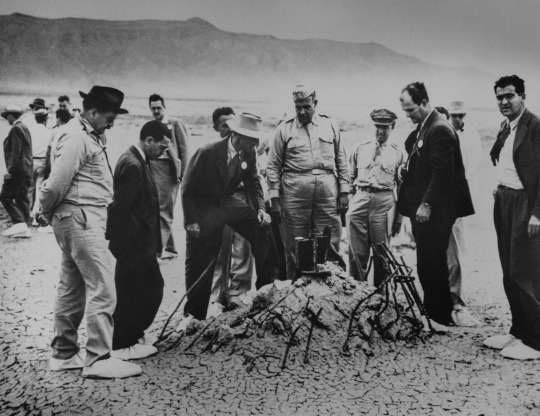
Manhattan Project leaders—including General Leslie Groves (center) and, to his right, physicist J. Robert Oppenheimer—scrutinize the remnants of the tower at ground zero. Upon seeing the detonation, Oppenheimer thought of a line from the Bhagavad Gita: "Now I am become Death, the destroyer of worlds." Photograph Via CORBIS/Getty
“The fact that there had not been a recognition of the impact of the very first atomic detonation in New Mexico was really simply wrong,” says Representative Teresa Leger Fernandez, a Democrat from New Mexico and co-sponsor of the House bill. “We hear their voices, we see their pain, and we must act.”
This is an especially urgent and consequential moment for those living in Trinity’s estimated fallout zone—some of whom have been waiting 76 years to be acknowledged. “We have been denied justice long enough,” says Bernice Gutierrez, who was a newborn when the bomb exploded. Her family lived in Carrizozo, about 50 miles from the blast site. “It’s not like we haven’t given our all to our country. What more can you give?”
‘A Very Serious Hazard’
The blast from the plutonium implosion device, nicknamed the Gadget, produced heat 10,000 times greater than the surface of the sun and was significantly more powerful than its creators had expected. It carried aloft hundreds of tons of irradiated soil and sent a mushroom cloud up to 70,000 feet in the sky. In this experimental atomic detonation, only three of the 13 pounds of plutonium at the bomb’s center underwent fission. The rest dispersed in the fallout cloud.
A tiny fraction of that three pounds of plutonium—about the weight of a raisin—was enough to release “three times the destructive force of the largest conventional bomb used in World War II,” says Robert Alvarez, associate fellow at the Institute of Policy Studies and former senior policy advisor to the U.S. Secretary of Energy. (The Gadget released an explosive force equivalent to about 21,000 tons of TNT.)
Right after detonation, the cloud divided into three parts. One part drifted east, another to the west and northwest, and the rest to the northeast, across a region a hundred miles long and 30 miles wide, “dropping its trail of fission products” the entire way, according to a 2010 report by the Centers for Disease Control and Prevention (CDC). The fallout eventually spread over thousands of square miles and was detected as far away as Rochester, New York.
Nineteen counties in New Mexico were in the downwind area, including 78 towns and cities, and dozens of ranches and pueblos. Radiation levels near homes in some “hot spots” reached levels “almost 10,000 times what is currently allowed in public areas,” according to the CDC.
“There is still a tremendous quantity of radioactive dust floating in the air,” wrote Stafford Warren to U.S. Army General Leslie R. Groves, head of the Manhattan Project, five days after the blast. Warren, the project’s chief medical officer, added that “a very serious [radiation] hazard” existed within a 2,700-square-mile area downwind of the test.
He also advised that future atomic tests be done only where there were no people within a radius of 150 miles. (Nearly half a million people in New Mexico, Texas, and Mexico lived within a 150-mile radius of the Trinity test.)
“We didn’t know what the hell we were doing,” Louis Hempelmann—the director of the Los Alamos Health Group, a team tasked with managing radiation within the Manhattan Project—reflected in a 1986 interview uncovered by sociologist James L. Nolan, Jr., in his book Atomic Doctors. “Nobody had had any experience like this before, and we were just hoping that the situation wouldn’t get terribly sticky.”
The leaders of the Manhattan Project knew that civilians had been “probably overexposed,” Hempelmann said. “But they couldn’t prove it and we couldn’t prove it. So we just assumed that we got away with it.”
Many civilians living within the estimated fallout zone were unwittingly exposed and sickened. According to Alvarez, even minute quantities of plutonium can inflict disease. “Particles of plutonium less than a few microns in diameter can penetrate deep in the lungs and lymph nodes and can also be deposited via the bloodstream in the liver, on bone surfaces, and in other organs,” he says. “If inhaled, extremely small amounts can lead to cancer.”
How is it, asks Senator Lujan, that RECA covered people living downwind of the Nevada Test Site but left out “the community where the first nuclear bomb was tested on American soil? There’s not been a good answer given to me nor to the downwinders in New Mexico. There’s no question of the exposure that resulted from the Trinity test.”
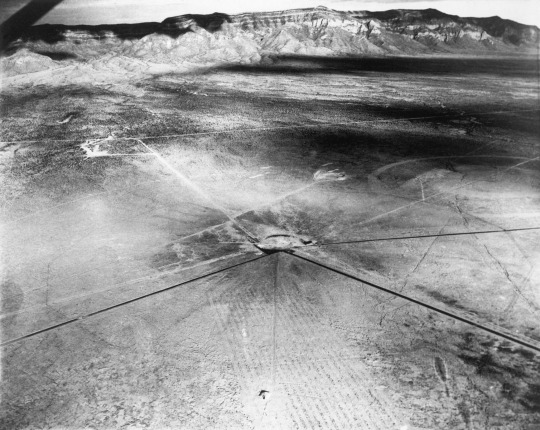
The explosion seared the desert sand surrounding the tower into a green, glass-like substance, named Trinitite. Photograph Via Bettmann/Getty
Something Felt Terribly Awry
Several people living near the test site later reported that they thought they were experiencing the end of the world. The strange, snowlike substance that fell from the sky for days coated everything: orchards, gardens, livestock, as well as cisterns, ponds, and rivers—the main sources of drinking water because local groundwater was “unsuitable for human consumption,” according to the 2010 CDC report.
One family in Oscuro, New Mexico, about 45 miles from the site, hung wet bedsheets in their windows against the fallout. They felt that something was terribly awry when their chickens and their dog died. Thirty miles away from ground zero, along Chupadera Mesa, burns appeared on the hides of cattle, whose fur eventually grew back gray and white in the burned patches.
A health care provider in Roswell, a hundred miles away, noted a surge in infant deaths there—35 in August 1945 alone. When she wrote to Warren, stating her concerns, his medical assistant replied that there were no “pertinent data” and assured her that “the safety and health of the people at large is not in any way endangered.”
“They Lied To Us. I Didn’t Learn The Truth Until Years Later.” — BatbaraKent, Trinity Test Survivor
For General Groves, getting the bomb ready—in secrecy—for wartime use had trumped all other considerations, including public safety.
Yet he realized that a blast whose flash was seen in at least three states and two countries could not be wholly concealed. He ordered the commanding officer of the Alamogordo Air Base to feed a cover story to the Associated Press that “a remotely located ammunition magazine containing a considerable amount of high explosives and pyrotechnics exploded.” There had been, the report went on, “no loss of life or injury.” Local newspapers reprinted the announcement without challenge.
Barbara Kent recalls that the day after the explosion, her camp’s dance instructor took the girls into Ruidoso, where government officials were to make an announcement about the source of the blast.
“It was so crowded downtown—everyone was shoulder to shoulder,” Kent says. “What they told us—there was an explosion at a dump. They said, ‘No one worry about anything, everything’s fine, just go along with your own business.’ Everyone was confused. Some people believed it, but some people thought they couldn’t imagine that a dump explosion would do this." She continues: "They lied to us. I didn’t learn the truth until years later.”
As time passed, Kent says she began to hear disturbing reports that her fellow campers were falling ill. By the time she turned 30, she says, “I was the only survivor of all the girls at that camp.” She adds that she has suffered from lifelong illnesses: She had to have her thyroid removed and has survived several forms of cancer, including endometrial cancer and “all kinds of skin cancers.”
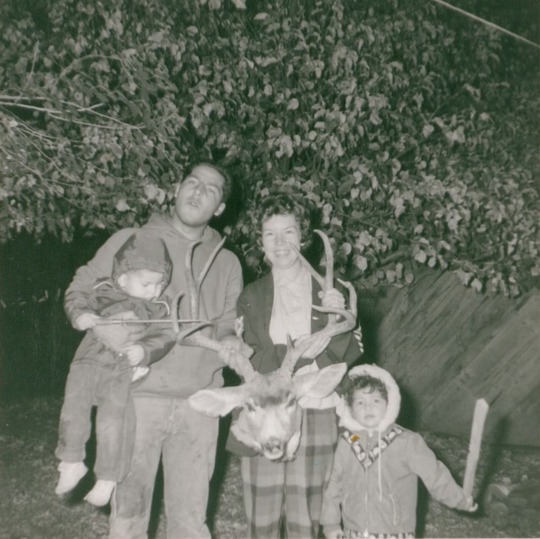
In this photograph from 1962, three-year-old Tina Cordova (bottom right) is pictured with her father, Anastacio (holding her baby brother, Matthew), and mother Rosalie. The young family lived in Tularosa, about 40 miles from the blast site. Everything they ate, Tina recalls, “was raised or grown or hunted," adding that the bomb’s “ash got everywhere, in the soil, in the water—everything was contaminated." She says her mother and father developed cancers, and she was diagnosed with thyroid cancer when she was 39. Courtesy of Anastacio and Rosalie Cordova
Tina Cordova is a fifth-generation resident of Tularosa, about 40 miles from the blast site. Thanks to an extensive ditch system in the area, the town was an oasis in the desert, and Cordova’s family’s home, like many others, had an orchard and garden.
“You could literally go out into your yard in the summer and eat peaches, apricots, cherries, figs, dates, pecans, walnuts—everything you could think of,” she says. Local people harvested and canned their fruit and collected rainwater for drinking from rooftop cisterns. Milk came from local dairies. People made their own butter and butchered farmyard animals or hunted wild animals for meat, including deer, quail, rabbit, and pheasant.
“Everything that people were consuming in 1945 was contaminated,” Cordova says. “But they didn’t know [the fallout was] dangerous. They went about their lives.”
After the test, she says, health problems began to plague her family, all of whom lived in and around Tularosa. According to Cordova, two of her great-grandfathers died of stomach cancer, and both of her grandmothers developed cancer. Two aunts had breast cancer, and one died from it. A cousin developed a brain tumor. Her mother had mouth cancer, and her sister has skin cancer. Her father, who was four at the time of the blast, suffered from various cancers, including prostate cancer and tongue cancer. Doctors had to remove part of his tongue and his lymph nodes. The cancer eventually spread to his neck and became inoperable. Cordova says he weighed about 125 pounds at his death in 2013 at the age of 71. She says that she herself was diagnosed with thyroid cancer in 1997, when she was 39.
‘When Are They Going To Hold Our Government Accountable?’
After the U.S. leveled Hiroshima with a uranium bomb on August 6, 1945, the secret history of the creation of atomic weapons was released and widely publicized. Many New Mexicans now realized that the blast that had shattered their windows and blanketed their homes in warm ash was not, after all, an ammunition dump explosion. Although they still hadn't been informed by the government about the nature of that ash or monitored for adverse health effects, they were encouraged to be proud of the part they’d unknowingly played in bringing about the dramatic new atomic age.
“When I was a child, the government fed us propaganda about how much pride we should take in the part we played in ending World War Two,” Cordova says. “We still did not know what that meant from a health consequence perspective. Our mom actually took us to the [Trinity] site for a picnic. We brought home as much Trinitite as we could and played with it.” (The Trinity Site is now a National Historic Landmark, open to visitors twice a year, and anyone can go online and buy radioactive fragments of Trinitite—a green glass created from sand and other materials that melted in the immediate blast zone.)

The U.S. Army erected this monument at ground zero in 1965. Ten years later, the National Park Service designated Trinity Site as a National Historic Landmark. It’s open to visitors twice a year, on the first Saturdays in April and October. Photograph By Tony Korody, SYGMA Via Getty
In 2004, Cordova read a letter from another Tularosa resident, Fred Tyler, to the editor of a local newspaper. She says that the letter changed her life. “He said, ‘When are they going to hold our government accountable for the damage they did to us?’ ” Cordova says. “I called him and said, ‘I feel the same way you do. It’s time to start an organization to more fully push the government about this issue.’ ”
In 2005, Cordova and Tyler founded the Tularosa Basin Downwinders Consortium (TBDC) as an advocacy organization for Trinity test downwinders.
At that time, she recalls, they weren’t aware that the Radiation Exposure Compensation Act had been in place for 15 years and already had provided onetime, $50,000 compensation to other downwinders who “may have developed cancer or other specified diseases after being exposed to radiation from atomic weapons testing or uranium mining, milling, or transporting.” Downwinder eligibility initially was limited to those within specified areas around the Nevada Test Site, 65 miles north of Las Vegas, where a hundred aboveground tests were conducted before a moratorium on atomic testing took effect in 1992.
In 2000, an amendment to RECA expanded eligibility to include some uranium miners and millers in New Mexico. Military and government workers who were “on-site participants” in the Trinity test were also eligible for compensation, but civilian downwinders remained ineligible.
Cordova, like Senator Lujan, says she has “never been able to get a straight answer” about why civilian downwinders were excluded from the legislation: “Even from people who were serving in Congress at the time, I’ve been told, ‘Well, no one was connecting the dots that anybody was harmed.’ ”
Bill Richardson—a Democrat who served as New Mexico’s governor from 2003 to 2011 and was a representative for the state’s Third Congressional District in 1990 when RECA was enacted—says, “I don’t think there was opposition [to their inclusion], just perhaps a lack of awareness. I didn’t know about their claims until I started reading about it when I was governor, and I was sympathetic.”
To raise awareness, Cordova and her colleagues at the consortium began to gather testimonies from and distribute health surveys to downwinders who were alive at the time of the Trinity test, along with their descendants who have lived in areas surrounding the test site. To date, the consortium has collected more than 1,000 surveys, and Cordova says that 100 percent of those questioned describe adverse health conditions—from thyroid disease to brain cancer—that can result from radiation exposure. Often participants describe similar cancers that have ravaged many family members over several generations.
‘A Now-or-Never Moment’
Cordova describes this effort to extend and expand RECA as a “now-or-never moment.” Senator Mike Crapo, an Idaho Republican and co-sponsor of the Senate bill, says there’s a “dire need for Congress to extend RECA … [and] to include victims in states across the West.”
“It is beyond time for the federal government to right a past wrong that caused harm to countless innocent Americans,” he wrote in a letter on March 24, 2021, to the chairman and members of the House Judiciary Committee.
“We Hear Their Voices, We See Their Pain, and We Must Act.” — TeresaLeger Fernandez, Representative to Congress, New Mexico
“When [RECA] was first introduced, no one considered the impact on the first downwinders,” Representative Fernandez says. “But we are in a place now where we recognize an injustice when we see it.” Her family lived in San Miguel and Guadalupe Counties in New Mexico, areas of potential exposure. She says her mother and sister—both nonsmokers—died of lung cancer. Her father died of esophageal cancer, she says, and her grandmother, who grew up near the Trinity site, died of leukemia.
Fernandez and Lujan say they’re also going to push for new epidemiological and environmental studies of the Trinity test’s aftermath and possible long-term effects.
Assessing Trinity’s exact “fingerprint” based on current fallout levels is “complicated and subject to large uncertainties,” says health physicist Joseph Shonka, co-author of the 2010 CDC report. He notes that residents of New Mexico have higher positive plutonium levels in their tissues than residents of any other state but says that tracing those levels back specifically to Trinity fallout might be difficult.
New Mexicans also may have internalized plutonium from various additional sources, he says, including general global fallout, releases from New Mexico’s Los Alamos plutonium operations, and fallout that drifted down from Nevada’s Test Site. The CDC recommended prioritizing Trinity’s aftermath for future studies.
Last year, the National Cancer Institute (NCI) released its findings from a nearly seven-year study of the Trinity nuclear test. The study’s lead investigator, Steven Simon, calls it the “most comprehensive study conducted on the Trinity test and its possible ramifications for cancer risks in the estimated fallout area.”
The researchers concluded that up to a thousand people may have developed cancer from the Trinity test fallout and that “only small geographic areas immediately downwind to the northeast received exposures of any significance.” They also said that the “plutonium deposited as a result of the Trinity test was unlikely to have resulted in significant health risks to the downwind population.”
The researchers also acknowledged their study’s limitations. Calculating exposure for those alive at the time of the detonation is “complex and is subject to uncertainties,” Simon explains, “because all of the needed data is not available."
Shonka says the new NCI study “failed to address early fallout adequately.” He says he questions some of the methodology and is preparing a counter-article addressing what he says are inconsistencies with previous findings. Other critics of the NCI study say it doesn’t address ongoing family cancer clusters and the reported 1945 spike in infant deaths in the region, documented in a 2019 paper in the Bulletin of the Atomic Scientists, co-authored by Robert Alvarez.
The NCI responds that its researchers focused on exposures received among “New Mexico residents alive at the time of the test,” and that they didn’t investigate the infant mortality because it was “not a cancer effect.”
Senator Lujan calls the NCI study “limited” and says that he wants to “make sure that there’s accurate data that truly is looking at the exposure that families face.”
“How can someone say that families in proximity to a nuclear blast were not exposed?” he asks. “It goes against everything that I’ve learned and data sets that I’ve seen from different parts of the world where this has happened, whether it’s been from meltdown of nuclear energy generation facilities or where weapons were deployed.”
Lujan continues, “People died as a result of the Trinity test—that’s a fact. People are still suffering—that’s a fact. The U.S. needs to come forward to address this liability, this wrong.”
Cordova says she and her community will be closely watching the RECA bills’ progress. The new legislation asks to expand compensation for individuals from $50,000 to $150,000. But beyond financial restitution, Cordova says, they’re also hoping simply for a government apology.
“We’ve never had an opportunity to live normal lives,” she says. “They can never say that they didn’t know ahead of time that radiation was harmful or that there was going to be fallout. We don’t ask if we’re going to get cancer; we ask when it’s going to be our turn. We are the forgotten collateral damage.”
— Lesley M. M. Blume is a New York Times best-selling historian, journalist, and author of Fallout: The Hiroshima Cover-up and the Reporter Who Revealed It to the World.
#United States 🇺🇸#US Lawmakers#Atomic Bomb 💣#Survivors#Lesley M.M. Blume#Barbara Kent#Ruidoso New Mexico#Manhattan Project’s Trinity Test#Alamogordo Bombing and Gunnery Range#Jornada del Muerto Valley#U.S. Congress#Radiation Exposure Compensation Act (RECA)#Two Billion Dollars 💵#Downwinders#New Mexico’s Senator Ben Ray Lujan (D)#Senator Mike Crapo (R—Idaho)#Rep. Teresa Leger Fernandez#Colorado Idaho and Montana#General Leslie Groves#J. Robert Oppenheimer#Serious Hazard#Louis Hempelmann#Los Alamos Health Group#Sociologist James L. Nolan Jr.#Terribly Awry#Government Accountable#Trinity Site#National Historic Landmark#Bill Richardson Governor New Mexico (D)
2 notes
·
View notes
Text
Every State Song, Ranked
Instead of listening to Christmas music or decorating the house on Christmas Eve, my sister and I listened to and ranked every single state song. Enjoy?
O, Fair New Mexico
Take Me Home, Country Roads - West Virginia
Oklahoma
Home On the Range - Kansas
Old Folks At Home (Swanee River) - Florida
Home Means Nevada
Rocky Mountain High - Colorado
Rocky Top - Tennessee
Alabama
Go, Mississippi
My Old Kentucky Home
Hail! South Dakota
Wyoming
Hawai’i Pono’i
Tennessee Waltz
On the Banks of the Wabash, Far Away - Indiana
Arizona March Song
Arkansas, You Run Deep In Me
Georgia On My Mind
Old New Hampshire
Alaska’s Flag
Missouri Waltz
All Hail to Massachusetts
Rhode Island, It’s For Me
Hail! Minnesota
Beautiful Nebraska
On, Wisconsin!
Montana
Illinois
I Love You, California
Oregon, My Oregon
Give Me Louisiana
Pennsylvania
Beautiful Ohio
State of Maine
Here We Have Idaho
Our Delaware
Utah, This Is the Place
Yankee Doodle - Connecticut
Carolina - South Carolina
Texas, Our Texas
North Dakota Hymn
I Love New York
I’m From New Jersey - unofficial
Washington, My Home
Our Great Virginia
The Old North State - North Carolina
These Green Mountains - Vermont
Michigan, My Michigan
The Song of Iowa
Maryland, My Maryland - removed in 2021
Best Melody: Take Me Home Country Roads, Home On the Range
Worst Melody: The Old North State, The Song of Iowa
Best Lyrics: Home Means Nevada, Alaska’s Flag
Worst Lyrics: Give Me Louisiana, I Love New York
Most Jammable: Old Folks at Home, Oklahoma
Least Jammable: These Green Mountains, Our Great Virginia
Most Original: O Fair New Mexico, Rocky Top
Least Original: Maryland My Maryland, Michigan My Michigan
#this took us hours#we did listen to multiple forms of each song!#enjoy#state songs#states#united states#usa#united states of america#america#american#songs#music#patriotic#california#new york#florida#o fair new mexico#take me home country roads#oklahoma#home on the range#old folks at home#swanee river#new mexico#west virginia#kansas
6 notes
·
View notes
Text

Super moon over New Mexico.
#laskowitzpictures photography color art travel unique#new mexico#sandia mountain range#sandias#supermoon#night photography#night#purple
2 notes
·
View notes
Text

Launch of A-004 Apollo Little Joe II (CSM-002/Vehicle 12-51-3) from LC-36 at White Sands Missile Range, New Mexico. This launch was to test the Intermediate Altitude Abort.
Date: January 20, 1966
NASA ID: 66-H-24A
#A-004#Apollo CSM Block I#CSM-002#Power-on Tumble Abort#Abort Test#Abort#Launch Escape System#LES#Little Joe II#Vehicle 12-51-3#Rocket#NASA#Apollo Program#White Sands LC-36#LC-36#White Sands Missile Range#White Sands#New Mexico#Launch#January#1966#my post
66 notes
·
View notes
Text

Max Lloyd-Jones and Rohan Campbell in Project Blue Book (2019) The Green Fireballs
S1E6
It's been two weeks since Fuller killed himself. Allen hasn't been sleeping and has been increasingly agitated, continually snapping at Mimi in not telling her anything about Blue Book including what happened to Fuller, in his guilt over what part he may have played in Fuller's death, that guilt which is only exacerbated by having watched him not flinch at all while he burned. The next reported sighting of something strange in the skies takes Allen and Quinn to White Forest Missile Testing Range in Nevada. Something inexplicable had set the countdown to a missile launch which would have killed all personnel on the range, and just as sudden the countdown stopped just seconds before the launch was to occur, followed by what were coined green fireballs shooting across the sky. Officially Allen wants to explain the green fireballs away as pure meteors, hiding his true beliefs. Allen has gained approval to set-up a motion sensor camera at the range in hopes of filming the green fireballs if and when they return. Allen's risky method of getting this approval, his more fulsome encounter with someone who he's seen before, and Quinn wanting to deal with someone unauthorized to be on the range, which Allen believes is none of their business, take them on diverging paths to the same hypothesis. Meanwhile, Susie is getting increasing pressure from her associate to wrap things up in Columbus in its entirety. Feeling she is close to something, Susie gets Mimi to do some of her dirty work in Mimi's frustration with Allen.
*The green lights were sighted over Los Alamos Military Base, New Mexico, which is where White Sands Missle Range is located and the site of the first atomic blast at the Trinity Site by the US scientists in 1944-45.
#Project Blue Book#2019#The Green Fireballs#S1E6#drama#mystery#scifi#Max Lloyd-Jones#Rohan Campbell#green lights#White Forest Missile Testing Range#Nevada#investigation#secrets#aliens#based on true events#Los Alamos Military Base#New Mexico#40s#just watched#tv series
1 note
·
View note
Video
Jet Fighter Taking Off From Holloman AFB (White Sands National Park) by Mark Stevens
Via Flickr:
A setting looking to the east while taking in views across the Interdune Boardwalk parking area in White Sands National Park. My thought in composing this image was to capture a view looking across the white sands with the scattered plant-life present. It would be more or less leveled on, but the focus would be on the skies above with the single Air Force fighter aircraft in the skies above (just below middle center). It had just taken off and was gaining altitude before the second fighter did it takeoff. While I had only zoomed in a little with the focal length, I was rather surprised with the detail my Nikon D850 did capture, looking at it later in post-production.
#Nikon D850#White Sands and West Texas New Mexico#Azimuth 91#Looking East#Day 2#White Sands National Park#Desert Mountain Landscape#Parking Area#Cars#Cars Parked#Air Force Fighter#Holloman AFB#Blue Skies#Blue Skies with Clouds#Interdune Boardwalk#SnapBridge#Intermountain West#Southwest Basins and Ranges#Southeast New Mexico Ranges#White Sands#White Sand Dunes#DxO PhotoLab 6 Edited#Gypsum Crystals#Tularosa Basin#Project365#Chihuahuan Desert#Desert#Desert Landscape#Desert Plant Life#Landscape
1 note
·
View note
Text
'Fans of "Oppenheimer" may find it difficult to visit the Trinity Site, the location of the world's first nuclear bomb detonation as featured in Christopher Nolan's latest film, released in theaters July 21.
The Trinity Site, located within White Sands Missile Range, New Mexico, is only open to visitors two days each year: Oct. 21, 2023, and April 6, 2024.
Those hoping to get a rare glimpse of Ground Zero of the Nuclear Age "may experience wait times of up to two hours," the statement reads.
"If you are not one of the first 5,000 visitors," the Army advises, you might not make it through the Missile Range's Stallion Gate before closing at 2 p.m. The Trinity Site closes promptly at 3:30 p.m. on Oct. 21. The Stallion Gate, outside of San Antonio, New Mexico, is around a three-hour drive from El Paso.
Oppenheimer age rating
The Oppenheimer movie is about the creation of the world's first nuclear weapon and deals with themes of war and violence. For this heavy subject matter, along with nudity, some sexual content, and explicit language, the film is rated R.
Oppenheimer run time
If you want to catch a screening of Oppenheimer before you try your luck at the Trinity Site in October, be prepared for a movie run time even longer than the expected wait to get into the Missile Range: Christopher Nolan's Oppenheimer movie is three hours long.
What is at Trinity Site, New Mexico?
The Trinity Site was chosen as a test location for the world's most deadly weapon by researchers like J. Robert Oppenheimer at the Los Alamos National Laboratory for its isolated desert environment. The landscape is as stark and empty as it was on July 16, 1945, when the bomb was tested.
Now an obelisk marks the exact location of the detonation, as well as some historical photographs and samples of trinitite — an extremely rare and "glasslike substance that was created from the sand and other materials ... during the intense heat of that first atomic test," according to the Los Alamos National Laboratory's Bradbury Science Museum.
Is Trinity Site still radioactive?
After the bomb's explosion in 1945, the military encircled the Trinity Site with chain-link fencing to keep both White Sands Missile Range personnel and the public away from dangerous radiation. Just eight years later in 1953, however, the radiation levels were deemed safe and the first public open houses of the area began.
Today it is safe to visit the Trinity Site, a public affairs specialist with White Sands Missile Range assured the El Paso Times in a 2018 interview. "If it wasn't," she added, "we wouldn’t open it to the public.”
Why is the Trinity Site only open twice a year?
Although the Trinity Site is a National Historic Landmark, representing "an outstanding aspect of American history and culture," it is located within the White Sands Missile Range, a highly active and restricted site for the U.S. Department of Defense.
Public access to the Trinity site is only open twice a year to comply with the military's frequent weapons testing at White Sands...'
1 note
·
View note
Text
i think when i finish school im gonna sell my house & move to new mexico...
#i absolutely love my house ..#but texas man .. i dont know if i want to stay here Forever#especially after this summer where its been 100 degrees every day for 2 months#& theres some houses for sale near alb that are like .. my dream home & in my price range ..#i want an old build with wood paneling/accents with an acre of land .. & theres so many like that around the edge of alb#plus theres the national forest there & absolutely beautiful scenery ..#& new mexico has better funding & opportunities for education- which is great because i want to teach when i graduate..#the only thing is that i absolutely love my house & feel bad leaving it behind#ive done so much work to it too ..#but in like a few years im probably gonna be the only one in my family left in texas#& if thats the case then i might as well move to my absolute dream home further north right#plus i dont know if yall know this but texas fucking sucks#the same ppl run the entire electric grid & just charge whatever the hell they want#our politicians actively try to kill us#& i get run off the road for having a black lives matter sticker. often#personal
0 notes